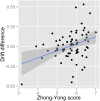Individual differences in Zhong-Yong tendency and processing capacity
- PMID: 25477842
- PMCID: PMC4237047
- DOI: 10.3389/fpsyg.2014.01316
Individual differences in Zhong-Yong tendency and processing capacity
Abstract
The present study investigated how an individual's Zhong-Yong tendency is related to his/her perceptual processing capacity. In two experiments, participants completed a Zhong-Yong Thinking Style Scale and performed a redundant-target detection task. Processing capacity was assessed with a non-parametric approach (systems factorial technology, SFT) and a parametric (linear ballistic accumulator model, LBA) approach. Results converged to suggest a positive correlation between Zhong-Yong tendency and processing capacity. High middle-way thinkers had larger processing capacity in multiple-signal processing compared with low middle-way thinkers, indicating that they processed information more efficiently and in an integrated fashion. Zhong-Yong tendency positively correlates with the processing capacity. These findings suggest that the individual differences in processing capacity can account for the reasons why high middle-way thinkers tend to adopt a global and flexible processing strategy to deal with the external world. Furthermore, the influence of culturally dictated thinking style on cognition can be revealed in a perception task.
Keywords: Zhong-Yong; individual differences; linear ballistic accumulator model; systems factorial technology; workload capacity.
Figures




References
-
- Chiu C.-Y. (2000). Assessment of Zhong-Yong (dialectic) thinking - preliminary findings from a cross-regional study. Hong Kong J. Soc. Sci. 18, 33–55.
-
- Colonius H., Townsend J. T. (1997). Activation-state representation of models for the redundant signals effect, in Choice, Decision, and Measurement: Essays in honor of R. Duncan Luce, ed Marley A. A. J. (Mahwah, NJ: Lawrence Erlbaum Associates; ), 245–254.
LinkOut - more resources
Full Text Sources
Other Literature Sources

